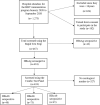Hepatitis B virus (HBV) serological patterns among the HBsAg negative hospital attendees screened for immunization
- PMID: 35523938
- PMCID: PMC9076922
- DOI: 10.1038/s41598-022-11535-8
Hepatitis B virus (HBV) serological patterns among the HBsAg negative hospital attendees screened for immunization
Abstract
The Hepatitis B virus (HBV) is a highly infectious virus and is endemic in Uganda. It is one of the major etiological agents for liver diseases including liver cancer. In this work, we evaluated the prevalence of the HBV serological markers and the associated socio-demographic factors among hepatitis B surface antigen (HBsAg) seronegative persons screened during routine immunization against the virus in eastern Uganda. Data on the socio-demographic characteristics were collected using a structured questionnaire, while that on the serological markers were obtained from serum samples and evaluated by using the 5-panel HBV One Step Hepatitis B Virus Combo Test Device (FastepR, HBV-P43M). The following markers were evaluated by the panel: HBsAg, HBsAb, HBcAb, and HBeAb. Data were analyzed using SPSS (version 26), and multinomial logistic regression was used to elicit the adjusted odds ratio. All the analysis were performed at a 95% confidence limit, and a P value ≤ 0.05 was considered significant. The 424 participants included in this study were mainly female (62.3%), married (55.4%) and aged 30 years and above (54.2%). The seropositivity of the HBsAb, HBeAb, HBcAb marker prevalence rates was 48(11.3%), 73(17.2%) and 45(10.6%) respectively. The majority of the participants (327, 77.1%) did not present with any marker. Married paricipants were significantly associated with reduced HBsAb seropositvity rate, whereas young people aged 18-29 years were associated the with increased odds of HBsAb seropositivity (p < 0.05). Male participants were significantly associated with the HBeAb and HBcAb seropositivity (p < 0.05). Similarly, contact with an HBV infected person was significantly associated with HBeAb and HBcAb seropositivity (p < 0.05). Further still, blood transfusion was significantly associated with the increased risk of HBcAb seropositivity (P < 0.05). This study has revealed a prevalence of HBV serological markers among the HBsAg seronegative persons in this community and an increased risk of transmission of the virus in the community. Our findings have key consequences pertaining the interventions that are pertinent in the control and prevention of the spread of the virus among apparently health persons.
© 2022. The Author(s).
Conflict of interest statement
The authors declare no competing interests.
Figures



Similar articles
-
Hepatitis B immunization status and risk factors of people aged 1 to 69 in Huangpu District, Shanghai, China.Front Public Health. 2023 Dec 14;11:1302183. doi: 10.3389/fpubh.2023.1302183. eCollection 2023. Front Public Health. 2023. PMID: 38179572 Free PMC article.
-
HBsAg (-)/HBsAb (-)/HBeAg (-)/HBeAb (+)/HBcAb (+) predicts a high risk of hepatitis B reactivation in patients with B-cell lymphoma receiving rituximab based immunochemotherapy.J Med Virol. 2023 Feb;95(2):e28549. doi: 10.1002/jmv.28549. J Med Virol. 2023. PMID: 36734081
-
Prevalence of Hepatitis B Virus Infection Markers among Patients of the Ibn Sina University Hospital Center (Rabat, Morocco).Intervirology. 2022;65(2):80-86. doi: 10.1159/000518618. Epub 2021 Sep 10. Intervirology. 2022. PMID: 34518480 Free PMC article.
-
Prevalence of some hepatitis B virus markers among pregnant women attending antenatal clinic in Specialist Hospital Sokoto Nigeria.Hum Antibodies. 2020;28(3):233-243. doi: 10.3233/HAB-200412. Hum Antibodies. 2020. PMID: 32333583
-
Renal grafts from anti-hepatitis B core-positive donors: a quantitative review of the literature.Transpl Infect Dis. 2012 Oct;14(5):445-51. doi: 10.1111/j.1399-3062.2012.00782.x. Epub 2012 Sep 12. Transpl Infect Dis. 2012. PMID: 22970743 Review.
Cited by
-
Potential of CRISPR/Cas system as emerging tools in the detection of viral hepatitis infection.Virol J. 2023 May 8;20(1):91. doi: 10.1186/s12985-023-02048-5. Virol J. 2023. PMID: 37158910 Free PMC article. Review.
-
Lateral Flow Assay for Hepatitis B Detection: A Review of Current and New Assays.Micromachines (Basel). 2023 Jun 12;14(6):1239. doi: 10.3390/mi14061239. Micromachines (Basel). 2023. PMID: 37374824 Free PMC article. Review.
-
The status of occult HBV infection in a high endemic region: risk of community HBV transmission and reactivation.BMC Res Notes. 2025 Jul 1;18(1):255. doi: 10.1186/s13104-025-07337-6. BMC Res Notes. 2025. PMID: 40598679 Free PMC article.
References
-
- Weinbaum C, Williams I, Mast E, Wang S, Finelli L, Wasley A. Recommendations for identification and public health management of persons with chronic hepatitis B virus infection. MMWR Recomm. Rep. 2008;2008:1–20. - PubMed
-
- Ganem D, Prince A. Hepatitis B virus infection–natural history and clinical consequences. N. Engl. J. Med. 2004;250:118–129. - PubMed
-
- UPHIA. UPHIA. Uganda Population HIV Impact Assessment. (2019).
Publication types
MeSH terms
Substances
LinkOut - more resources
Full Text Sources
Medical

